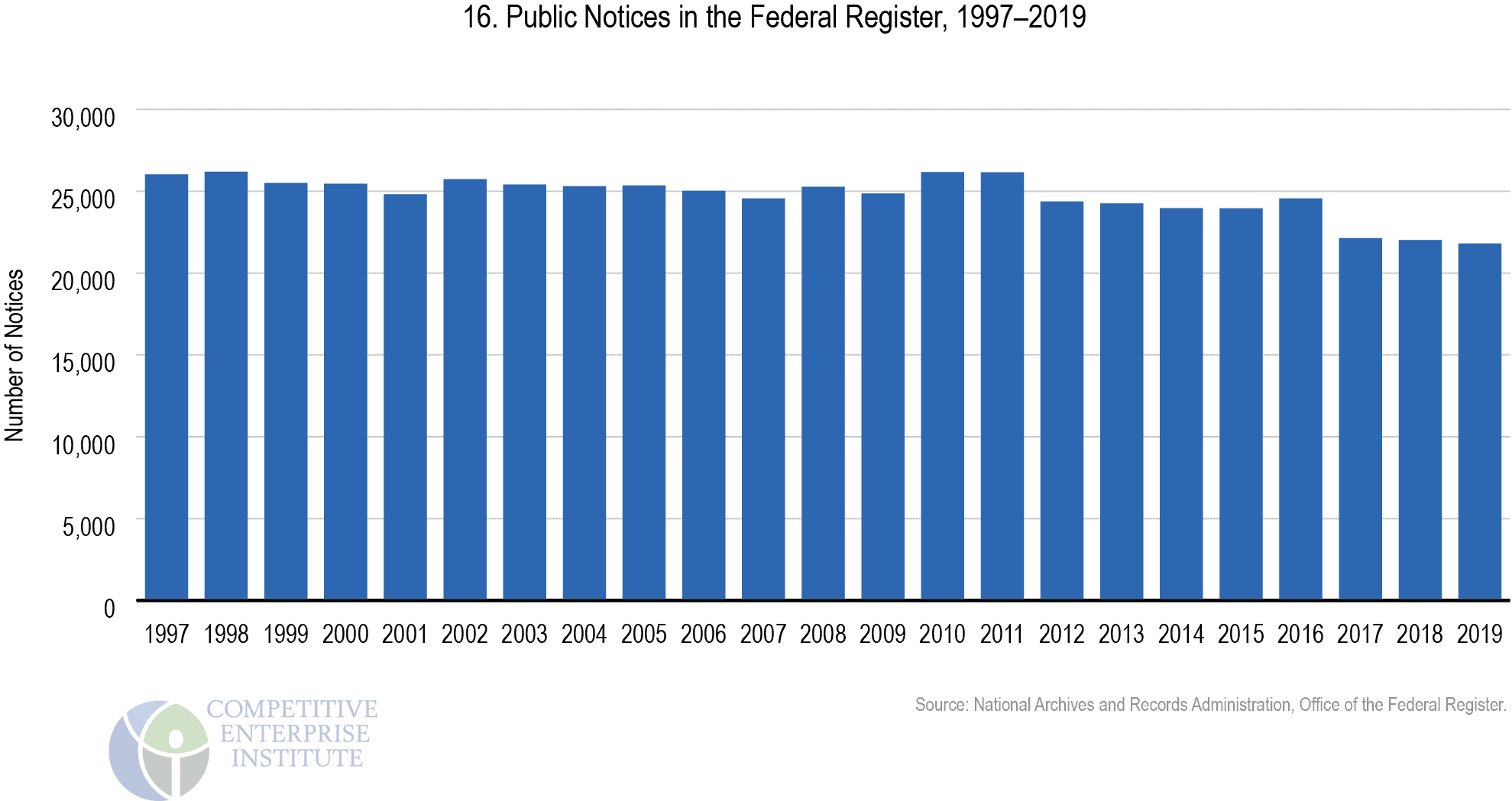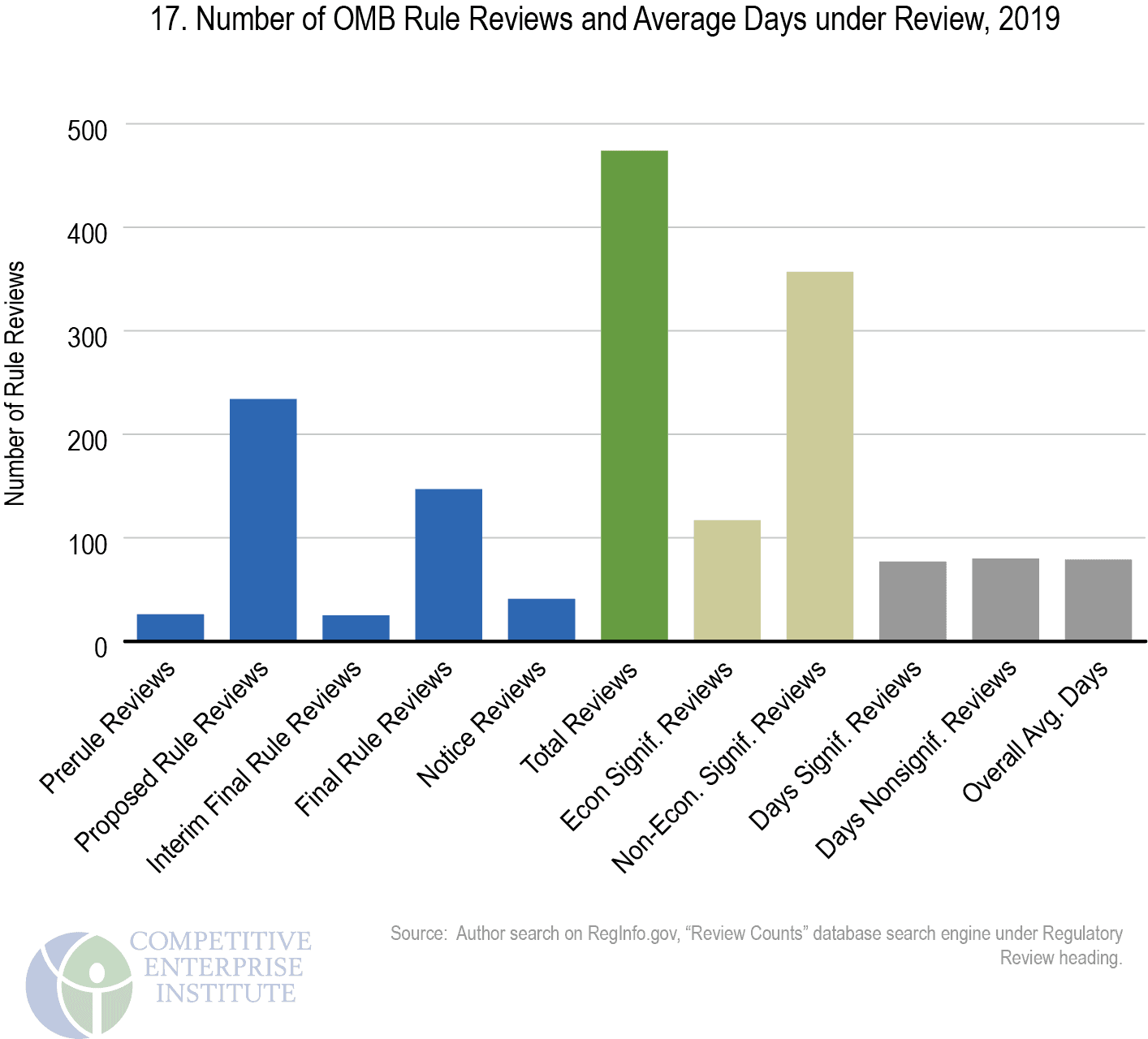Regulatory Dark Matter: Over 22,000 Public Notices Annually
Ten Thousand Commandments 2020 - Chapter 7

Download Chapter 7 as a PDF
Without actually passing a law, government can signal expectations, specify parameters for and influence various industries—including health care, retirement, education, energy production, finance, land and resource management, science and research, and manufacturing—through various kinds of guidance documents. A prominent Obama era example is the Internal Revenue Service’s granting of waivers of the Patient Protection and Affordable Care Act’s employer mandate despite the statute’s language.449 In one assessment, a 2018 report by the House Committee on Oversight and Government Reform found at least 13,000 guidance documents that had been issued since 2008.450
Guidance documents are difficult to pin down, a situation addressed in the new Executive Order 13891, “Promoting the Rule of Law through Improved Agency Guidance Documents,” with its requirement for inventories, which will feature in future editions of Ten Thousand Commandments. In addition to the Federal Register’s tally of rules, public notices appear in the Federal Register. These typically consist of non-rulemaking documents such as meeting and hearing notices and agency-related organizational material. But the tens of thousands of yearly public notices can also include memoranda, bulletins, guidance documents, alerts, and other proclamations, many of which may be consequential to the public.451
Figure 16 depicts the number of notices published annually in the Federal Register. These peaked at over 26,000 during 2010–2011.


Standing at 21,804 at year-end 2019, these have dipped below 24,000 only five times since 1996, including Trump’s first three years (the other years were 2014 and 2015). There have been 616,455 public notices since 1994 and well over 1 million since the 1970s, but, again, many of those are trivial.
Given that many notice-and-comment regulations already lack cost-benefit or other analysis, policy makers should pay greater attention to the “notices” component of the Federal Register, given the modern administrative state’s inclination to advance policy by memorandum, notice, letter, bulletin, and other means. Yet much guidance does not appear in the Federal Register. Increased unilateral executive proclamations atop “traditional” rules and regulations will render costs and effects of regulation even less transparent than they already are. As the House Oversight Committee detailed in a 2018 report, Shining Light on Regulatory Dark Matter, of at least 536 known significant guidance documents issued since 2008, just 328 were submitted to OMB for review. Furthermore, while 13,000-plus guidance documents should have been submitted to both Congress and the GAO as required by the Congressional Review Act, only 189 were.452
Rule Reviews at OMB’s Office of Information and Regulatory Affairs
The president and Congress can assure that more review and supervision of guidance documents and notices take place. As it stands, while agencies issued thousands of “notices,” only 41 received OMB review during calendar year 2019, up from 24 in Trump’s first year, and on par with the 45 during Obama’s last. Several dozen notices reviewed by OMB have been deemed to have an economically significant effect in recent years.453 Figure 17 presents the number of rule reviews conducted by OMB, by stage and by economic significance, for calendar year 2019. It also shows the number of days OMB took to review rules in 2019, a process that improved during recent years but that at times can take several months.
A history of the number of rules and notices reviewed annually by OIRA appears in Appendix: Historical Tables, Part D, in which a detailed breakdown is presented of numbers of rules reviewed by type and by average days for review from 1991 through 2019. During the pre–Executive Order 12866 years depicted there, 1991–1993, review times were shorter, although numbers of rules were considerably higher then. During the Trump administration’s first 18 months, it was claimed that OIRA reviewed 70 percent fewer regulatory actions than were reviewed under the Obama administration and 66 percent fewer than in the George W. Bush administration.454 Trump’s total review counts still have not hit Obama’s 2016 tally, but are otherwise comparable.
Tracking effects of rules and regulations, executive orders, memoranda, and other regulatory guidance is vital. These alternative regulatory actions should receive more scrutiny and oversight, since they have become powerful means of working around the constitutional system of government envisioned by the Framers: legislation enacted by elected representatives.